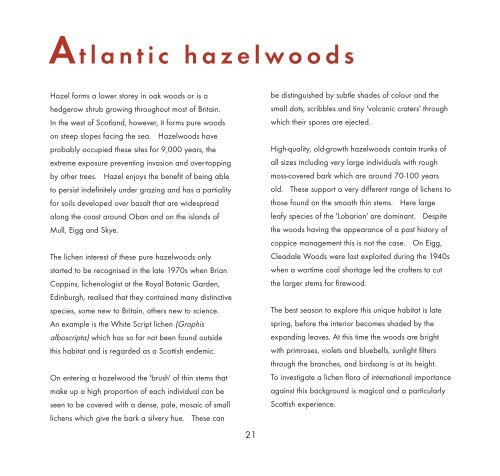Lichens Lichens - Scottish Natural Heritage
Lichens Lichens - Scottish Natural Heritage
Lichens Lichens - Scottish Natural Heritage
Create successful ePaper yourself
Turn your PDF publications into a flip-book with our unique Google optimized e-Paper software.
A tlantic hazelwoods<br />
Hazel forms a lower storey in oak woods or is a<br />
hedgerow shrub growing throughout most of Britain.<br />
In the west of Scotland, however, it forms pure woods<br />
on steep slopes facing the sea. Hazelwoods have<br />
probably occupied these sites for 9,000 years, the<br />
extreme exposure preventing invasion and over-topping<br />
by other trees. Hazel enjoys the benefit of being able<br />
to persist indefinitely under grazing and has a partiality<br />
for soils developed over basalt that are widespread<br />
along the coast around Oban and on the islands of<br />
Mull, Eigg and Skye.<br />
The lichen interest of these pure hazelwoods only<br />
started to be recognised in the late 1970s when Brian<br />
Coppins, lichenologist at the Royal Botanic Garden,<br />
Edinburgh, realised that they contained many distinctive<br />
species, some new to Britain, others new to science.<br />
An example is the White Script lichen (Graphis<br />
alboscripta) which has so far not been found outside<br />
this habitat and is regarded as a <strong>Scottish</strong> endemic.<br />
On entering a hazelwood the 'brush' of thin stems that<br />
make up a high proportion of each individual can be<br />
seen to be covered with a dense, pale, mosaic of small<br />
lichens which give the bark a silvery hue. These can<br />
21<br />
be distinguished by subtle shades of colour and the<br />
small dots, scribbles and tiny 'volcanic craters' through<br />
which their spores are ejected.<br />
High-quality, old-growth hazelwoods contain trunks of<br />
all sizes including very large individuals with rough<br />
moss-covered bark which are around 70-100 years<br />
old. These support a very different range of lichens to<br />
those found on the smooth thin stems. Here large<br />
leafy species of the 'Lobarion' are dominant. Despite<br />
the woods having the appearance of a past history of<br />
coppice management this is not the case. On Eigg,<br />
Cleadale Woods were last exploited during the 1940s<br />
when a wartime coal shortage led the crofters to cut<br />
the larger stems for firewood.<br />
The best season to explore this unique habitat is late<br />
spring, before the interior becomes shaded by the<br />
expanding leaves. At this time the woods are bright<br />
with primroses, violets and bluebells, sunlight filters<br />
through the branches, and birdsong is at its height.<br />
To investigate a lichen flora of international importance<br />
against this background is magical and a particularly<br />
<strong>Scottish</strong> experience.

















